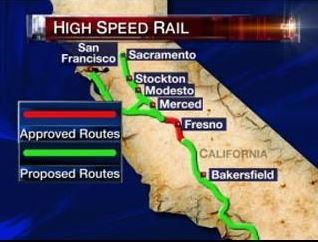7 ways James Fallows is wrong about the CA bullet train
by Chris Reed | July 11, 2014 8:15 am
 Writing on The Atlantic’s website, the much-respected journalist/intellectual James Fallows — a Redlands native who knows California better than nearly all other national pundits — has come out as a big fan[1] of the state’s bullet-train project. He promises to return frequently to the project in coming months and explain all the ways that it is wonderful.
Writing on The Atlantic’s website, the much-respected journalist/intellectual James Fallows — a Redlands native who knows California better than nearly all other national pundits — has come out as a big fan[1] of the state’s bullet-train project. He promises to return frequently to the project in coming months and explain all the ways that it is wonderful.
In his first installment, his focus is on how much better life is in places with fast, convenient trains and how big infrastructure projects can tranform regions for the better. Then he cites studies which talk about this specific project’s benefits in helping local economies and reducing pollution.
The problem is that Fallows is describing California’s high-speed rail project in a vacuum. When someone just hears the concept, of course they are likely to think it sounds cool.
But the California project is not proceeding in a vacuum. It is unfolding under specific parameters governed by state law and under the specific circumstances we’ve seen in California since 2008, when state voters approved Proposition 1A and $9.95 billion in bond seed money for the train. When you look at the pet project of the California High-Speed Rail Authority with these factors in mind, it’s obvious that Fallows, as smart as he may be, is clueless on the bullet train.
Beyond the happy talk: What reality looks like
Here are seven ways that is the case.
1. All the wonderful things the train allegedly does don’t matter if it can’t be paid for. There is at most $13 billion in state and federal funding for a project that has a price tag of $68 billion (a price tag that no one really believes is accurate). There is no prospect for further federal funding[2] in an era in which discretionary domestic spending is being squeezed as never before. State funding of $250 million a year from fees from California’s nascent cap-and-trade pollution-rights market begins this budget cycle. But that is a pittance, and if they’re off the record, no state lawmaker will admit to wanting taxpayers to foot the entire bill. So why can’t the private sector come to the rescue? Because …
2. All the wonderful things the train allegedly does don’t matter if it can’t be built legally. No private sector investors have emerged despite years of promises from the administrations of Arnold Schwarzenegger and Jerry Brown because Prop 1A included a provision that there could be no operating subsidies, whether the rail system was run by the state government or a private operator. No investor wants to partner with a suspect entity like the state of California without revenue or ridership guarantees that are tantamount to promises of subsidies if the project doesn’t meet expectations.
The bullet train isn’t just susceptible to the NIMBYism that routinely hobbles big projects. The only lawyers who believe the state’s proposal is legal under the terms of Prop 1A work for the rail authority or for political entities that support the project. It’s already been blocked by a Sacramento Superior Court judge[3] on the grounds that it has inadequate financing and insufficient environmental reviews to begin construction of its initial $31 billion, 300-mile link. That’s because of yet another Prop 1A safeguard: the requirement that construction couldn’t begin unless there is all necessary money in hand and completed environmental reviews for an entire rail segment that could be economically viable even if the statewide system were never completed.
 3. What the state of California wants to do isn’t even a high-speed rail project under the definition established in state law. Fallows somehow has missed the harsh critique of former state Sen. Quentin Kopp, the father of the bullet train idea in California, who opposes Brown’s plan[4] to build a really fast train from San Jose to the northern edges of the Los Angeles exurbs. Kopp says — correctly — that Prop 1A promised a two-hour, 40-minute trip from downtown San Francisco to downtown L.A. That’s not in the realm of even theoretical possibility if riders have to spend an hour getting from San Francisco to San Jose and then an hour getting from northern L.A. County to downtown L.A. on regular trains.
3. What the state of California wants to do isn’t even a high-speed rail project under the definition established in state law. Fallows somehow has missed the harsh critique of former state Sen. Quentin Kopp, the father of the bullet train idea in California, who opposes Brown’s plan[4] to build a really fast train from San Jose to the northern edges of the Los Angeles exurbs. Kopp says — correctly — that Prop 1A promised a two-hour, 40-minute trip from downtown San Francisco to downtown L.A. That’s not in the realm of even theoretical possibility if riders have to spend an hour getting from San Francisco to San Jose and then an hour getting from northern L.A. County to downtown L.A. on regular trains.
Public, lawmakers have cooled to project
Now it’s time for four more reasons that are a little more subjective but that Fallows still has no effective way to counter:
4. The Fallows case for the bullet train builds on information he was provided by the state and its paid consultants. Unless he is the most naive man in the world, he should be hugely suspicious of information provided by those pushing the project. Why? Because here is the short list of some of the many important things they have deceived the public and the media about since 2008:
The project’s cost[5] (used to be $33 billion, then $98 billion, now allegedly $68 billion); annual ridership forecasts[6] (initially an insane 117 million people, or three times as many riders as Amtrak, which operates in 46 states); jobs created; pollution reduction; and cost of fares.
5. The public no longer backs the project. It won narrowly in 2008. Now polls show nearly two-thirds of voters[7] are opposed. Costly projects surrounded by controversy and scandal — and lacking funding — need public support if they are to be completed.
6. Many Democrats in the state Legislature have lost faith. The incoming Senate president, Kevin De Leon of Los Angeles, even said it was stupid to begin the project[8] in the Central Valley instead of the state’s most populated regions. And the most dominant special interests in Sacramento are public employee unions, not the building-trades unions which love the bullet train. These unions are extremely wary of another big mouth at the state trough. An enormously expensive bailout of the state teachers pension system has just gotten under way; a similar bailout of a program for retiree health care for state employees is still badly needed; and temporary income-tax and sales-tax hikes are expiring in coming years. These factors add up to a grim coming era in which there will be a perpetual dog-eat-dog fight for every dollar in the Legislature. These are the fights that the teacher unions in particular win year after year. There is no reason to think teacher unions will use their clout to help the bullet-train project as opposed to trying to enervate it.
7. The idea that trains dependent on conventional 20th-century engineering are the key to getting people around in 21st-century California is farcical to anyone who pays attention[9] to the enormous building wave of transformative transportation technology[10]. Driverless cars are only one example.
Fallows’ goal seems to be shoring up a project he perceives in trouble. But unless he moves out of his vacuum-based view of high-speed rail’s glories and addresses its California realities, he’s not even going to be a factor in debates over the bullet train — at least in the Golden State.
That’s because here, we’ve already heard all the happy talk. And we’ve noticed how little it meshes with reality.
- big fan: http://www.theatlantic.com/business/archive/2014/07/the-california-high-speed-rail-debate-kicking-things-off/374135/
- further federal funding: http://www.utsandiego.com/news/2013/Apr/11/bullet-train-no-federal-funding-forthcoming/
- Sacramento Superior Court judge: http://www.smdailyjournal.com/articles/lnews/2013-11-26/judge-blocks-bullet-train-funds-california-high-speed-rail-authoritys-request-to-sell-8b-of-the-10b-in-bonds-denied/1776425113992.html
- opposes Brown’s plan: http://californiawatch.org/dailyreport/ex-bullet-train-booster-calls-new-plan-mangled-perhaps-illegal-17007
- project’s cost: http://www.mercurynews.com/ci_22929875/california-high-speed-rail-costs-soar-again-this
- ridership forecasts: http://www.city-journal.org/2012/cjc0321cr.html
- nearly two-thirds of voters: http://articles.latimes.com/2011/dec/06/local/la-me-train-poll-20111207
- stupid to begin the project: http://www.latimes.com/local/la-me-cap-de-leon-20140621-column.html
- pays attention: http://www.uspirg.org/reports/usp/new-way-go
- transformative transportation technology: http://blog.euromonitor.com/2013/04/driverless-cars-the-coming-green-transportation-revolution.html
Source URL: https://calwatchdog.com/2014/07/11/8-ways-james-fallows-is-clueless-about-the-ca-bullet-train/